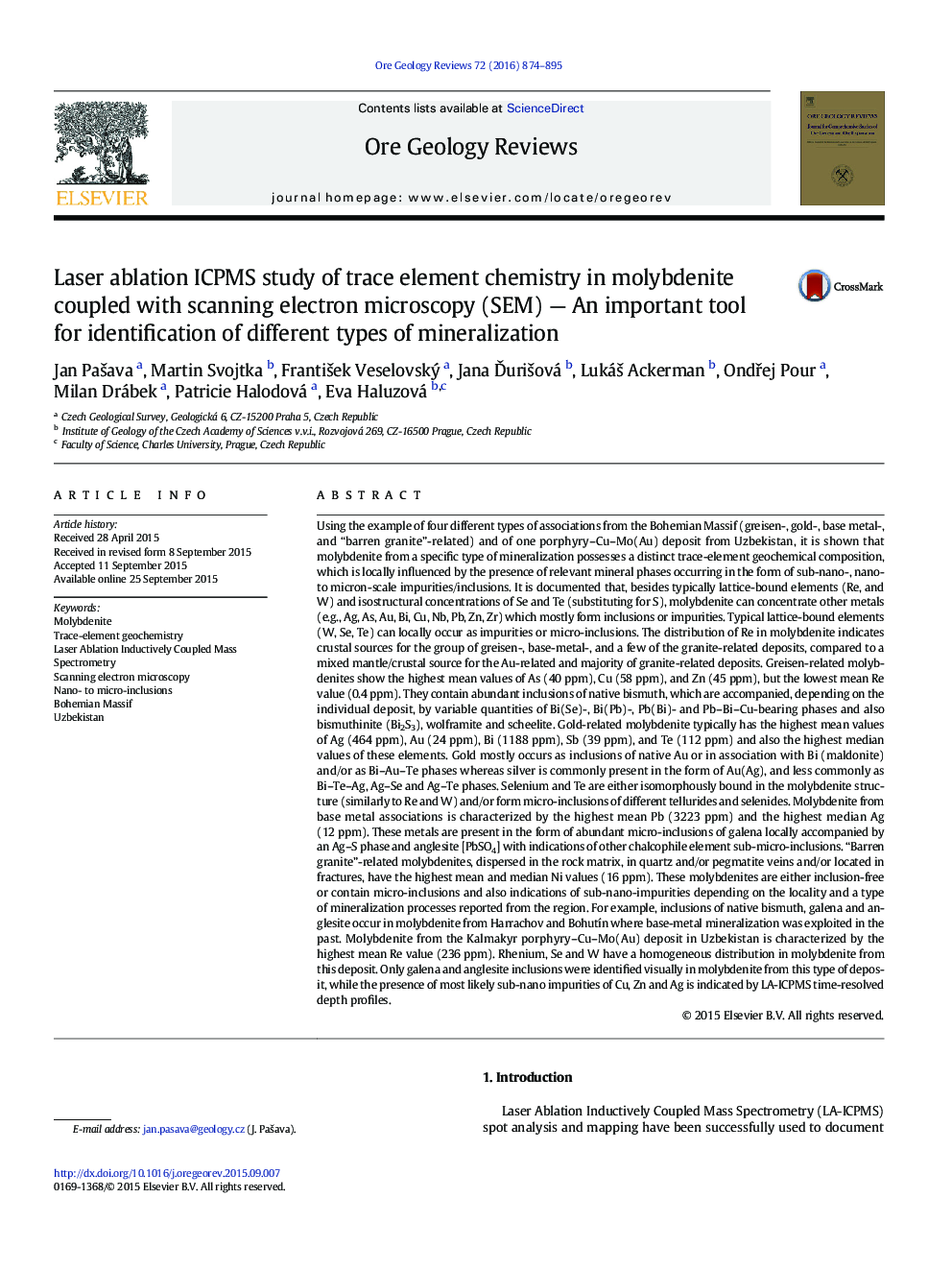| کد مقاله | کد نشریه | سال انتشار | مقاله انگلیسی | نسخه تمام متن |
|---|---|---|---|---|
| 6435809 | 1351852 | 2016 | 22 صفحه PDF | دانلود رایگان |

- We present new LA-ICPMS and mineralogical data in molybdenite from different associations
- We how different mineralization processes are fingerprinted in of molybdenite chemistry and mineralogy
- We demonstrate heterogeneity of molybdenites at micro- to nano-scales
- We show that Re concentrations are mostly controlled by different sources of melt/fluid
Using the example of four different types of associations from the Bohemian Massif (greisen-, gold-, base metal-, and “barren granite”-related) and of one porphyry-Cu-Mo(Au) deposit from Uzbekistan, it is shown that molybdenite from a specific type of mineralization possesses a distinct trace-element geochemical composition, which is locally influenced by the presence of relevant mineral phases occurring in the form of sub-nano-, nano- to micron-scale impurities/inclusions. It is documented that, besides typically lattice-bound elements (Re, and W) and isostructural concentrations of Se and Te (substituting for S), molybdenite can concentrate other metals (e.g., Ag, As, Au, Bi, Cu, Nb, Pb, Zn, Zr) which mostly form inclusions or impurities. Typical lattice-bound elements (W, Se, Te) can locally occur as impurities or micro-inclusions. The distribution of Re in molybdenite indicates crustal sources for the group of greisen-, base-metal-, and a few of the granite-related deposits, compared to a mixed mantle/crustal source for the Au-related and majority of granite-related deposits. Greisen-related molybdenites show the highest mean values of As (40Â ppm), Cu (58Â ppm), and Zn (45Â ppm), but the lowest mean Re value (0.4Â ppm). They contain abundant inclusions of native bismuth, which are accompanied, depending on the individual deposit, by variable quantities of Bi(Se)-, Bi(Pb)-, Pb(Bi)- and Pb-Bi-Cu-bearing phases and also bismuthinite (Bi2S3), wolframite and scheelite. Gold-related molybdenite typically has the highest mean values of Ag (464Â ppm), Au (24Â ppm), Bi (1188Â ppm), Sb (39Â ppm), and Te (112Â ppm) and also the highest median values of these elements. Gold mostly occurs as inclusions of native Au or in association with Bi (maldonite) and/or as Bi-Au-Te phases whereas silver is commonly present in the form of Au(Ag), and less commonly as Bi-Te-Ag, Ag-Se and Ag-Te phases. Selenium and Te are either isomorphously bound in the molybdenite structure (similarly to Re and W) and/or form micro-inclusions of different tellurides and selenides. Molybdenite from base metal associations is characterized by the highest mean Pb (3223Â ppm) and the highest median Ag (12Â ppm). These metals are present in the form of abundant micro-inclusions of galena locally accompanied by an Ag-S phase and anglesite [PbSO4] with indications of other chalcophile element sub-micro-inclusions. “Barren granite”-related molybdenites, dispersed in the rock matrix, in quartz and/or pegmatite veins and/or located in fractures, have the highest mean and median Ni values (16Â ppm). These molybdenites are either inclusion-free or contain micro-inclusions and also indications of sub-nano-impurities depending on the locality and a type of mineralization processes reported from the region. For example, inclusions of native bismuth, galena and anglesite occur in molybdenite from Harrachov and BohutÃn where base-metal mineralization was exploited in the past. Molybdenite from the Kalmakyr porphyry-Cu-Mo(Au) deposit in Uzbekistan is characterized by the highest mean Re value (236Â ppm). Rhenium, Se and W have a homogeneous distribution in molybdenite from this deposit. Only galena and anglesite inclusions were identified visually in molybdenite from this type of deposit, while the presence of most likely sub-nano impurities of Cu, Zn and Ag is indicated by LA-ICPMS time-resolved depth profiles.
Journal: Ore Geology Reviews - Volume 72, Part 1, January 2016, Pages 874-895